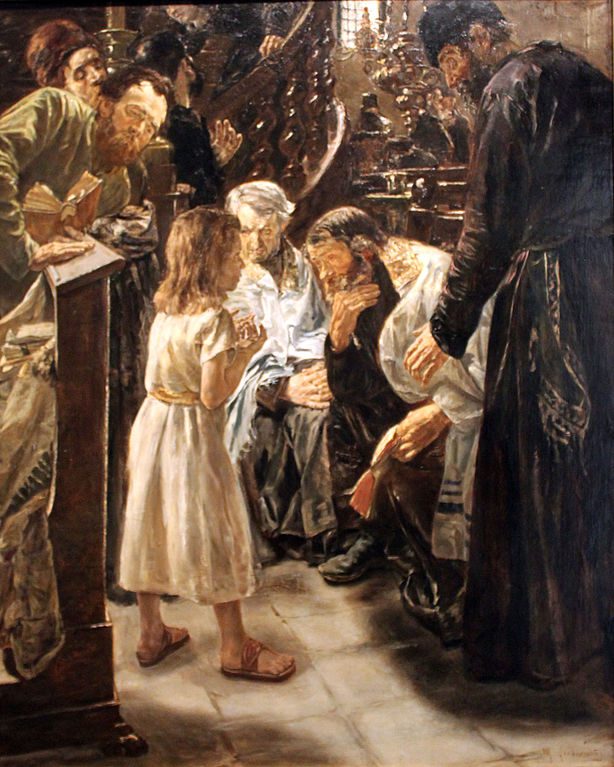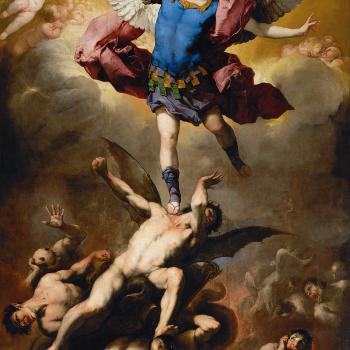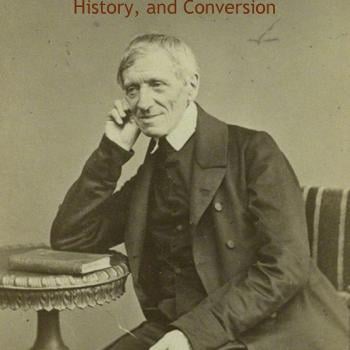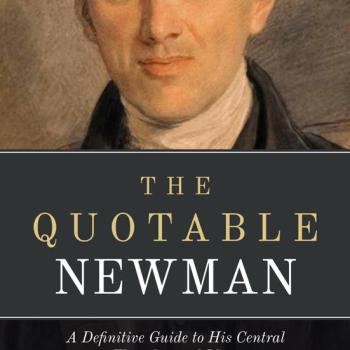
The Twelve-Year-Old Jesus in the Temple (1879), by Max Liebermann (1847-1935) [public domain / Wikimedia Commons]
* * * * *
See my earlier related papers:
Young Messiah Denies Christological Certainties [3-12-16]
Jesus Always Knew He Was God (Young Messiah) [3-14-16]
Young Messiah, Dramatic License, & Biblical Theology [3-18-16]
* * *
Catholic apologist (and my friend) Jimmy Akin has given us a thought-provoking article about the issue of Jesus’ knowledge (not specifically about The Young Messiah). It’s entitled, “The Magisterium and the Human Knowledge of Christ” (The Catholic World Report, 3-18-16). Much of the following is my reply and sort of a “thinking out loud” (since Jimmy’s work is always challenging and insightful, and we disagree slightly on a few things). His words will be in blue.
* * * * *
Hi Jimmy,
Excellent article, as always. Thanks very much for it!
As a critic of the theology of The Young Messiah, I still have some questions I am now working through, as a result of reading your article, and taking in the new information I have gleaned from it.
My main purpose in critiquing the film (which I have seen) was to note that it denied what seemed to me to be a firm teaching of the faith: that Jesus always knew He was God and didn’t have to learn it at some point. A few points on this, if I may:
You wrote that, “The response of the Magisterium was firm, and in 1907 the Holy Office . . . issued a decree that rejected as erroneous the proposition that “Christ did not always possess the consciousness of his Messianic dignity” (Lamentabili 35).
That seems clear enough: a magisterial condemnation of a notion that this movie contradicts.
You cite the Pontifical Biblical Commission (not itself magisterial), in 1984, stating that Jesus “grows more and more in the awareness of the mission entrusted to him by the Father, from his childhood up to his death on the cross” (Instruction on Scripture and Christology 2:2:1:3b).
Does this necessarily contradict the former statement, though? Does awareness of particulars in His mission entail that we can speculate that He didn’t know He was God? Can we not distinguish between those two things? Otherwise, the 1907 proclamation seems rather nonsensical. If we separate these two aspects, the two are harmonious. Or so I submit . . .
You then cite International Theological Commission (ITC): also “not an organ of the Magisterium”, and make note of its 1985 document, “The Consciousness of Christ Concerning Himself and His Mission.” It defends four theses, including the one I am primarily concerned with, with regard to The Young Messiah: “Jesus knew that he was God and the Son of God.” You inform us that “it does not specify when he came to know these things.”
Okay; is it not most plausible, then, to assume that it is consistent with (or perhaps presupposes) the idea that Jesus knew of His own identity from conception, in light of much (if not the broad consensus of) patristic and medieval teaching, and the statements from Pope Pius XII about His possessing the Beatific Vision from conception (and the 1907 condemnation)? Why would we assume otherwise?
I don’t know what to make of Pope St. John Paul II’s statements about Jesus and the Beatific Vision. Perhaps he meant it in different senses. But in any event, there must (it seems to me) be some difference between Jesus’ possession of it while on the earth and after He died.
Dr. Ludwig Ott, in his Fundamentals of Catholic Dogma stated:
Christ’s soul possessed the immediate vision of God from the first moment of its existence. (Sent. certa.) (p. 162)
Christ’s human knowledge was free from positive ignorance and from error. (Sent. certa.) Cf. D2184 et seq.” (p. 165)
Ott goes on to say that: “The Fathers implicitly teach the doctrine that Christ’s soul always enjoyed the Beatific Vision by reason of the fact that they teach that Christ as man had fullness of knowledge as a consequence of the Hypostatic Union.” (p. 163)
Dr. Ott explains “Sent. certa.” (pp. 9-10) as follows:
A Teaching pertaining to the Faith, i.e., theologically certain (sententia ad fidem pertinens, i.e., theologice certa) is a doctrine, on which the Teaching Authority of the Church has not yet finally pronounced, but whose truth is guaranteed by its intrinsic connection with the doctrine of revelation (theological conclusions).
That’s pretty strong: “theologically certain” and “guaranteed.” Are we to believe that such level of teaching could develop (in the classic Newmanian conception) into something different, or get reversed by the Church? That seems very unlikely. For how could a “certain” and “guaranteed” teaching be reversed? That would mean it wasn’t certain or guaranteed, after all.
Here are nine other doctrinal examples in Ott in Christology (and one Marian doctrine) that he classifies as sent. certa:
1) “The Hypostatic Union was never interrupted” (p. 150).
2) Adoration of Jesus’ Sacred Heart (p. 159).
3) “Christ’s Humanity, as instrument of the Logos, possesses the power of producing supernatural effects” (p. 172).
4) “Christ’s soul was subject to sensual emotions” (p. 174).
5) “God was not compelled to redeem mankind by either an internal or an external compulsion” (p. 178).
6) “Christ is the Supreme Prophet promised in the Old Testament and the absolute teacher of humanity” (p. 180).
7) “Christ merited for Himself the condition of exaltation (Resurrection, Transfiguration of the body, Ascension into Heaven” (p. 190).
8) “Christ merited all supernatural graces received by fallen mankind” (p. 190).
And regarding the Blessed Virgin Mary:
9) “Mary, the Mother of God, is entitled to the Cult of Hyperdulia” (p. 215).
None of these teachings seem to me to be of the sort that they would be reconsidered or reversed. Yet we are to believe that Jesus’ possessing the Beatific Vision from conception is a teaching that can be overthrown? Is it not easier to believe that it is presupposed, and that Pope St. John Paul II must have nuances in his argument that distinguish different senses of this notion, rather than attempting to reverse a sent. certa. teaching?
You write, “The Catechism makes no mention of Jesus having the beatific vision in this life. The threefold division of Christ’s human knowledge into beatific, infused, and acquired knowledge is absent, and the subject is treated from a different angle.”
Fair enough, but by the same token, this doesn’t necessitate a denial of same. It could merely have presupposed it, and/or thought it was non-necessary in this particular section, or (possibly) not appropriate to include in a catechetical work for the masses.
Moreover, no one on either side of this dispute questions that Jesus acquired some knowledge in his human nature (St. Thomas Aquinas taught that). Thus, non-mention of that in this part of the Catechism does not entail anyone denying that theological teaching, or denying that the Church has generally held it. Likewise, by analogy, the Beatific Vision.
You write:
“Von Balthasar proposed that in his human knowledge Christ supernaturally knew not all real states of affairs but specifically what pertained to his mission (see, esp., his book Theo-Drama, vol. 3, 163-202).
“The Catechism reflects this, stating that Christ’s human knowledge contained whatever pertained to “the eternal plans he had come to reveal.” “
I would say that this human knowledge includes the knowledge (from conception) that He was God — something that even John the Baptist in the womb knew [Lk 1:39-44]; yet we are to believe that God the Son didn’t until he was seven: according to The Young Messiah and various theological theories?
I was curious about more particulars in Balthasar, so I did an extensive search of this book in Google Books. Unfortunately, it didn’t include page numbers, but I found the following statements (in chronological order) that indicate (if I understand them correctly) that he thought Jesus always possessed this knowledge:
1) C. Trinitarian Inversion
Jesus is aware that he has received a mission from the father and is its complete embodiment in the world. We cannot conceive that this awareness ever had a beginning.
2) . . . his mission (which has no conceivable beginning; he did not discover it subsequently) . . . he is the one who has always consented to it — ‘for this I came’ (Jn 10:10) . . .
3) For Jesus, there is no conceivable point at which this identity of his ‘I’ and his mission started; from the very moment of his conception, therefore, this identification must have taken place, either as event or as process . . .”
Thus, if Balthasar is one of the primary theological minds behind what you say is recent development of this matter, he seems to be on the side of Jesus knowing His identity from conception and indeed, without “beginning”: which is what Pope Pius XII was saying. He is expressing the same thing: at least regard with Jesus’ knowledge of His own Divinity, which is my sole concern, and the belief that was denied in the film.
As for Pope Benedict, I’d like to see more specifics of what he wrote. If he ever denied outright that there was any time that Jesus did not know He was God, in His human nature, surely that can be produced (I’d love to see such a thing), and we wouldn’t have to speculate at all. If it can’t be found, then it seems we ought to follow the clear traditional (or “older” if you will) teaching that you have outlined and that I have defended, and assume that he followed it and has not held that it is no longer “theologically certain”.
You state: “The picture that emerges from these data points is of a shift away from the medieval consensus and a return to streams of thought found among the Church Fathers.”
I think there is some shift in particulars of how exactly Jesus can grow in wisdom. I’m not convinced that older magisterial statements are somehow reversed or overthrown or shown to be less than “theologically certain.”
The Congregation for the Doctrine of the Faith (CDF), under the direction of Cardinal Ottaviani, also issued a document on July 24, 1966, that asserted:
[S]ome of the documents examined by this Sacred Congregation contain affirmations which easily go beyond the limits of hypothesis or simple opinion, appearing to raise certain questions regarding the dogmas and fundamentals of the faith.
It is worthwhile to draw attention to some examples of these opinions and errors that have arisen both from the reports of competent persons and in published writings.
[. . .]
5) The venerated Person of Our Lord Jesus Christ is called into question when, in the elaboration of the doctrines of Christology, certain concepts are used to describe his nature and his person though they are difficult to reconcile with that which has been dogmatically defined. A certain Christological humanism is twisted such that Christ is reduced to the condition of an ordinary man who, at a certain point, acquired a consciousness of his divinity as Son of God. The virginal birth, miracles, and the resurrection itself are admitted only as concepts, reduced to a purely natural order.
[. . .]
These pernicious errors, scattered variously throughout the world, are recounted in this letter only in summary form for the local Ordinaries so that each one, according to his function and office, can strive to eradicate or hinder them.
It’s tough to see how a teaching can go from being asserted by the PBC and Pope Pius XII (the denial of which is described as “pernicious error” and “twisted” by the CDF in 1966), and being sent. certa. in Ott’s classifications of dogma, to being completely open to reinterpretation.
I can’t make sense of those kinds of changes in the Church’s views, with regard to Jesus’ knowledge of His own Divinity. I can see it with regard to other applications of his human knowledge, considered strictly on its own.
I am most curious as to your replies to the issues I have raised. Thanks for your time in reading and considering all this, and I wish you a very blessed Holy Week.
Dear Dave,
Thank you very much for your kind and thoughtful response. I will do my best to respond in a brief space to the points you raise.
1) Christ’s human knowledge of the fact he is God is a subcase of the broader topic my article covers. I know it’s the subject you’re principally interested in due to The Young Messiah, but my article is more generally focused on the shift in the magisterium’s attitude regarding the human knowledge of Christ. I’d be more specific about subcases if I could.
Certainly one can maintain that the film is in error in depicting Christ not being sure of his divine identity at age seven. [my bolding in these two paragraphs] At the same time, I would be careful about charging the film with heresy (or with making any charge of heresy).
Heresy involves the denial of a teaching that the Church has infallibly defined as being divinely revealed, and I don’t know where the Church has infallibly defined that it has been divinely revealed that Jesus knew this at age seven. (I believe he did know it, but to make an allegation of heresy, I need to be able to show that the Church has infallibly defined it as divinely revealed that he did). The thesis most commonly used to support that idea–that Christ knew all real states of affairs from conception based on his possession of the beatific vision from conception–was only listed by Ott as certain, not as de fide.
2) Regarding Ott, it should be pointed out that the theological notes (sent. certa, sent. communior, de fide, etc.) that he assigns propositions represent his theological opinions. They are not official assignments made by Church authority. While his opinions are often good, they are not authoritative.
To some extent, English-speakers have relied too much on Ott’s theological notes because his is the only popular work in print and in English that uses theological notes. With no other opinions to compare them to, people tend to assume Ott’s notes must be correct.
If John Paul II teaches something that contradicts one of Ott’s notes, the former takes precedence, as John Paul II teaches with authority and Ott has an opinion to the contrary.
3) It also should be pointed out that Ott was a manualist. In fact, Fundamentals of Catholic Dogma is a theological manual. When he says that something is sent. certa, it means that he (and some/many other manualists) felt certain of it.
However, manualistic theology is precisely the approach that Ratzinger and the other leaders of the Ressourcement wished to call into question. It is thus not surprising if manualists like Ott felt certain of things that Ressourcement leaders like Ratzinger did not think were certain.
Ott’s notes indicate what one school of thought held was certain, but the magisterium later took a broader perspective that was open to other schools of thought as well. It is therefore not surprising that the magisterium later treated some of Ott’s certainties as less than certain.
I therefore would not rely on Ott’s opinion that something is theologically certain if later magisterial developments point in a different direction.
4) It seems clear that John Paul II says that Jesus gained the beatific vision upon death, not conception. This does not mean that his human soul did not have prior, supernatural knowledge by virtue of the hypostatic union (it did have such knowledge), but it does mean that the magisterium is no longer making the claim regarding the beatific vision that Pius XII did, which means that conclusions based on the prior claim may or may not hold.
5) The fact the Catechism does not appeal to the beatific vision or use the classical threefold division of Christ’s human knowledge in its section on Christ’s human knowledge is an indication of the shift that has taken place.
The authors of the Catechism obviously thought it was appropriate to include a section on Christ’s human knowledge in a catechetical work of this nature, and for them to include one that takes a non-classical approach to the subject indicates that the subject has been rethought and the classical approach is no longer the one (or the only one) the Church wishes to present to the faithful.
6) The CDF statement that you cite from 1966 (which I initially had in my piece, but I had to cut it for space and flow reasons) is from the Ottaviani era.
Ottaviani was an ally of the manualists and a critic of Ressourcement theologians. The statement therefore represents a data point that is in continuity with the classical stream of thought, before the magisterial shift.
The fact that the shift occurred does not mean that the 1966 statement would be repudiated today, though it does mean that the 1966 statement cannot be read as if the shift had not occurred.
Thanks again for replying, and I hope you and your family have a blessed Holy Week!
Hi Jimmy,
Thanks for your reply. Again, it was very helpful. I understood that your article dealt with a much broader issue (Jesus’ human knowledge).
Regarding my central concern with The Young Messiah we are in agreement (I think!), since you wrote: “Certainly one can maintain that the film is in error in depicting Christ not being sure of his divine identity at age seven” and “I believe he did know [His divine identity].”
That’s all I’ve said about it, and the only thing I saw wrong with it, excepting one possibly problematic prayer from Mary, in which she said, “forgive us our sins.”
Originally, I used the term “heresy” in my critique: indeed, in the title of my first post on the film. It was pointed out to me by Bryan Cross that use of that term for denial of doctrines of less authority than de fide was improper, so (several days ago now) I removed it from my first two papers.
I’ve since described it as “serious error” and a denial of a teaching described by Ott as “theologically certain.” Whether Ott’s categories are erroneous is, no doubt, another huge discussion, and of relatively less interest to me (though I would be curious to see a treatment of that question).
But even if he is disputable in individual instances, there is still undoubtedly a classification of the relative authority of teachings, and this one seems to me to be pretty high on the scale.
In any event, we agree that such a view (Jesus’ ignorance of His Divinity at age seven) is erroneous, and I have yet to see anything from the magisterium that would entail or establish such a view.
Now some are contending (trying to “play it down the middle”) that the film does not imply that Jesus didn’t know that He was God, but that hardly seems possible, as He shows confusion throughout the film regarding His miraculous powers, and [possible spoiler alert!] Mary tells Him near the end that He is the “Son of God” (I believe that was the term used).
Thus, the implication throughout was that He did not know this till the time at the end of the film, when He was still seven years old. Indeed, I would say that this was the central theme or plot line of the movie.
Whether His possession of the Beatific Vision is necessary for this self-knowledge, or necessary or required in general, I gladly leave for the theologians and magisterium to work out. But it seems much more doctrinally certain that He knew He was God from the beginning. Even Balthasar agrees with that (the quotations I provided), and I understand that he has flatly denied that Jesus possessed the Beatific Vision.
Your contributions have made the larger discussion a bit more confusing and “unsure” (to me, anyway), yet more fascinating at the same time.
I wrote and asked my friend, theologian Dr. Robert Fastiggi, about Ott’s classifications, since he is the editor and translator of an upcoming revision of Fundamentals of Catholic Dogma (due to come out anytime now). He agreed that “Ott’s theological notes are his own opinion” and that “theological notes have been superseded to some extent by the three levels of assent to magisterial teaching expressed by the 1989 Profession of Faith and the 1998 CDF Commentary on this Profession.” He promised to write back later, at greater length, so hopefully he can provide more clarity about the issue at hand.
Msgr. Arthur Burton Calkins, in his paper, “The Teaching of Pope John Paul II on the Sacred Heart of Jesus and the Theology of Reparation, Part 1” (2014) makes the following striking observation:
Unfortunately it must be acknowledged that, since at least the conclusion of the Second Vatican Council – although not as a result of it – there has been a consistent rejection on the part of many theologians of the Church’s traditional belief in the threefold human knowledge of Christ and, in particular, of his possessing the beatific vision in his earthly life. The primary reason for this rejection seems to be the assumption that the classical doctrine on the human knowledge of Christ is incompatible with contemporary psychological theory. Such an assumption is particularly regrettable since in this area everything depends on what psychological theory a given theologian chooses to base himself. A theory that dominates in the field today may be abandoned tomorrow. Because of the instability which has been injected into the postconciliar theological scene as a result of this rejection and because the papal magisterium has not made any subsequent pronouncements on the level of those made by Pius XI and Pius XII, there has been a tendency on the part of some to assume that the teaching of these popes is no longer binding.
I believe that such reasoning is clearly unacceptable for several reasons. First, because, if a tenet of the faith has been continually taught and held with moral unanimity by pastors and theologians for a long period in the Church, it simply cannot be jettisoned, even if no longer supported by a consensus of theologians. Otherwise there is no absolute truth; everything is reduced to relativism on the basis of what is theologically fashionable and we know that fashions by their very nature change from one day to the next. Secondly, it is not necessary for every pope to restate all Catholic doctrine. “An authentic exercise of the ordinary papal magisterium need not be repeated on the same subject” as Stackpole rightly states. Thirdly, not only has this doctrine never been rejected by the magisterium, but it has been reaffirmed in various ways, as we will now see.
He continues in Part 2, analyzing Pope St. John Paul II’s views in particular:
[I]f John Paul II has not used the classical language of “beatific” and “infused” knowledge in teaching about Christ’s human knowledge and consciousness, neither has he avoided the issue. In an illuminating discourse which he gave at his general audience of 30 November 1988 on Jesus’ cry from the cross, “My God, my God, why have you forsaken me?”, the Pope commented:
Dominant in his mind Jesus has the clear vision of God and the certainty of his union with the Father. But in the sphere bordering on the senses, and therefore more subject to the impressions, emotions and influences of the internal and external experiences of pain, Jesus’ human soul is reduced to a wasteland, and he no longer feels the “presence” of the Father, but he undergoes the tragic experience of the most complete desolation. …
In the sphere of feelings and affection this sense of the absence and abandonment by God was the most acute pain for the soul of Jesus who drew his strength and joy from union with the Father. This pain rendered more intense all the other sufferings. That lack of interior consolation was his greatest agony.
If the Pope does not use the technical language of “beatific vision” here, one can hardly doubt that he is referring to it. In effect, he is presenting the classical doctrine from a psychological perspective, which at once respects the teaching of the previous magisterium while striving to penetrate into the human experience of Christ’s dereliction during his agony and on the cross. [Calkins’ emphasis; my link added]
Now, I am inclined (with my love of development of doctrine) to favor this interpretation. He says that Pope St. John Paul II and also Pope Benedict (more on that below) are actually developing the older insights in a way that incorporates some of the more “psychological” / “stressing the humanity of Jesus” insights of theologians over the last 60 or so years. Perhaps (just a random thought) they don’t use the term “Beatific Vision” because some would immediately dismiss their thoughts? By using the limited term “vision” maybe they can develop the classical theology and come up with some new insights that harmonize the best in both lines of thought? I’m just thinking out loud.
Msgr. Calkins then cites at length Pope St. John Paul II’s Apostolic Letter Novo Millennio Ineunte of 6 January 2001 [which was just cited at length above] (italics were in the EWTN posting; blue passages are my own selections from among Calkin’s more extensive italicized highlighting):
A face of sorrow
25. In contemplating Christ’s face, we confront the most paradoxical aspect of his mystery, as it emerges in his last hour, on the Cross. The mystery within the mystery, before which we cannot but prostrate ourselves in adoration.
The intensity of the episode of the agony in the Garden of Olives passes before our eyes. Oppressed by foreknowledge of the trials that await him, and alone before the Father, Jesus cries out to him in his habitual and affectionate expression of trust: “Abba, Father”. He asks him to take away, if possible, the cup of suffering (cf. Mk 14:36). But the Father seems not to want to heed the Son’s cry. In order to bring man back to the Father’s face, Jesus not only had to take on the face of man, but he had to burden himself with the “face” of sin. “For our sake he made him to be sin who knew no sin, so that in him we might become the righteousness of God” (2 Cor 5:21).
We shall never exhaust the depths of this mystery. All the harshness of the paradox can be heard in Jesus’ seemingly desperate cry of pain on the Cross: ” ‘Eloi, Eloi, lama sabachthani?‘ which means, ‘My God, my God, why have you forsaken me?’ ” (Mk 15:34). Is it possible to imagine a greater agony, a more impenetrable darkness? In reality, the anguished “why” addressed to the Father in the opening words of the Twenty-second Psalm expresses all the realism of unspeakable pain; but it is also illumined by the meaning of that entire prayer, in which the Psalmist brings together suffering and trust, in a moving blend of emotions. In fact the Psalm continues: “In you our fathers put their trust; they trusted and you set them free … Do not leave me alone in my distress, come close, there is none else to help” (Ps 22:5,12).
26. Jesus’ cry on the Cross, dear Brothers and Sisters, is not the cry of anguish of a man without hope, but the prayer of the Son who offers his life to the Father in love, for the salvation of all. At the very moment when he identifies with our sin, “abandoned” by the Father, he “abandons” himself into the hands of the Father. His eyes remain fixed on the Father. Precisely because of the knowledge and experience of the Father which he alone has, even at this moment of darkness he sees clearly the gravity of sin and suffers because of it. He alone, who sees the Father and rejoices fully in him, can understand completely what it means to resist the Father’s love by sin. More than an experience of physical pain, his Passion is an agonizing suffering of the soul. Theological tradition has not failed to ask how Jesus could possibly experience at one and the same time his profound unity with the Father, by its very nature a source of joy and happiness, and an agony that goes all the way to his final cry of abandonment. The simultaneous presence of these two seemingly irreconcilable aspects is rooted in the fathomless depths of the hypostatic union.
27. Faced with this mystery, we are greatly helped not only by theological investigation but also by that great heritage which is the “lived theology” of the saints. The saints offer us precious insights which enable us to understand more easily the intuition of faith, thanks to the special enlightenment which some of them have received from the Holy Spirit, or even through their personal experience of those terrible states of trial which the mystical tradition describes as the “dark night”. Not infrequently the saints have undergone something akin to Jesus’ experience on the Cross in the paradoxical blending of bliss and pain. In the Dialogue of Divine Providence, God the Father shows Catherine of Siena how joy and suffering can be present together in holy souls: “Thus the soul is blissful and afflicted: afflicted on account of the sins of its neighbour, blissful on account of the union and the affection of charity which it has inwardly received. These souls imitate the spotless Lamb, my Only-begotten Son, who on the Cross was both blissful and afflicted”. In the same way, Thérèse of Lisieux lived her agony in communion with the agony of Jesus, “experiencing” in herself the very paradox of Jesus’s own bliss and anguish: “In the Garden of Olives our Lord was blessed with all the joys of the Trinity, yet his dying was no less harsh. It is a mystery, but I assure you that, on the basis of what I myself am feeling, I can understand something of it”. What an illuminating testimony! Moreover, the accounts given by the Evangelists themselves provide a basis for this intuition on the part of the Church of Christ’s consciousness when they record that, even in the depths of his pain, he died imploring forgiveness for his executioners (cf. Lk 23:34) and expressing to the Father his ultimate filial abandonment: “Father, into your hands I commend my spirit” (Lk 23:46).
Msgr. Calkins summarizes:
The first very important point made by the Pope and consistently repeated in various ways is that in approaching the question of Christ’s human consciousness during his agony and passion we are dealing with a profound mystery of the faith, indeed, he calls it “the mystery within the mystery” and says that before it “we cannot but prostrate ourselves in adoration”.
Secondly, his teaching about Jesus’ enjoyment of the beatific vision, even in the bitter experience of his passion, is unmistakable. He says that Jesus’ “eyes remain fixed on the Father” and is emphatic about “the knowledge and experience of the Father which he alone has, even at this moment of darkness”. With this affirmation he ratifies and synthesizes the theological, mystical and magisterial tradition of which he is the heir. . . .
Now it is true that John Paul II did not present the theological question with the specific finality of seeking to know how our “retroactive” reparation could bring consolation to Jesus in his passion; his is the even more fundamental question of how Jesus could experience “at one and the same time his profound unity with the Father” and an unspeakable agony. His answer i.e., that “The simultaneous presence of these two seemingly irreconcilable aspects is rooted in the fathomless depths of the hypostatic union”, in no way invalidates the response of Pius XI in Miserentissimus Redemptor, but further confirms it.
Even Fr. Joseph S. O’Leary: openly and proudly “liberal” or “progressive” in outlook, in effect conceded:
I am told that John Paul II, in the retreat he gave for Paul VI, preached that Jesus enjoyed the beatific vision while in his mother’s womb (also stated in Pius XII, Mystici Corporis, 1943). Benedict has not taken up that tradition here, but one may surmise that he believes Jesus to have enjoyed the beatific vision throughout his earthly mission. The question of Christ’s self-consciousness is at the heart of Benedict’s quarrel with the historico-critical method. (“Benedict XVI on Jesus”: 6-15-07)
Of great relevance to our question is a recent book by a Dominican, Simon Francis Gaine, entitled, Did the Saviour See the Father?: Christ, Salvation, and the Vision of God (London: Bloomsbury / T & T Clark, 2015). He refers (pp. 3-5) to a massive shift in theology (alluded to in Jimmy Akin’s article): away from the predominantly “Thomistic” / classical / traditional position (that Christ possessed the Beatific Vision from conception) to something different.
Yet, the Notification on the Works of Father Jon Sobrino, SJ, published by the Congregation for the Doctrine of the Faith (CDF), under William Cardinal Levada on 26 November 2006, and approved by Pope Benedict XVI, appeared to rather dramatically (some would say, surprisingly) reaffirm traditional teaching, though in somewhat different terminology (my blue highlighting; italics in original on the Holy See website):
V. The Self-consciousness of Jesus
8. Citing Leonardo Boff, Father Sobrino affirms that “Jesus was an extraordinary believer and had faith. Faith was Jesus’ mode of being” (Jesus the Liberator, 154). And for his own part he adds: “This faith describes the totality of the life of Jesus” (Ibidem, 157). The Author justifies his position citing the text of Hebrews 12:2: “Tersely and with a clarity unparalleled in the New Testament, the letter says that Jesus was related to the mystery of God in faith. Jesus is the one who has first and most fully lived faith (12:2)” (Christ the Liberator, 136-137). He further adds: “With regard to faith, Jesus in his life is presented as a believer like ourselves, our brother in relation to God, since he was not spared having to pass through faith. But he is also presented as an elder brother because he lived faith as its ‘pioneer and perfecter’ (12:2). He is the model, the one on whom we have to keep our eyes fixed in order to live out our own faith” (Ibidem, 138).
These citations do not clearly show the unique singularity of the filial relationship of Jesus with the Father; indeed they tend to exclude it. Considering the whole of the New Testament it is not possible to sustain that Jesus was “a believer like ourselves”. The Gospel of John speaks of Jesus’ “vision” of the Father: “Not that anyone has seen the Father except the one who is from God; he has seen the Father”.[20] This unique and singular intimacy between Jesus and the Father is equally evident in the Synoptic Gospels. [21]
The filial and messianic consciousness of Jesus is the direct consequence of his ontology as Son of God made man. If Jesus were a believer like ourselves, albeit in an exemplary manner, he would not be able to be the true Revealer showing us the face of the Father. This point has an evident connection both with what is said above in number IV concerning the relationship between Jesus and the Kingdom, and what will be said in VI below concerning the salvific value that Jesus attributed to his death. For Father Sobrino, in fact, the unique character of the mediation and revelation of Jesus disappears: he is thus reduced to the condition of “revealer” that we can attribute to the prophets and mystics.
Jesus, the Incarnate Son of God, enjoys an intimate and immediate knowledge of his Father, a “vision” that certainly goes beyond the vision of faith. The hypostatic union and Jesus’ mission of revelation and redemption require the vision of the Father and the knowledge of his plan of salvation. This is what is indicated in the Gospel texts cited above.
Various recent magisterial texts have expressed this doctrine: “But the knowledge and love of our Divine Redeemer, of which we were the object from the first moment of His Incarnation, exceed all that the human intellect can hope to grasp. For hardly was He conceived in the womb of the Mother of God when He began to enjoy the Beatific Vision”. [22]
Though in somewhat different terminology, Pope John Paul II insists on this vision of the Father: “His [Jesus’] eyes remain fixed on the Father. Precisely because of the knowledge and experience of the Father which he alone has, even at this moment of darkness he sees clearly the gravity of sin and suffers because of it. He alone, who sees the Father and rejoices fully in him, can understand completely what it means to resist the Father’s love by sin”. [23]
Likewise, the Catechism of the Catholic Church speaks of the immediate knowledge which Jesus has of the Father: “Such is first of all the case with the intimate and immediate knowledge that the Son of God made man has of his Father”. [24] “By its union to the divine wisdom in the person of the Word incarnate, Christ enjoyed in his human knowledge the fullness of understanding of the eternal plans he had come to reveal”. [25]
The relationship between Jesus and God is not correctly expressed by saying Jesus was a believer like us. On the contrary, it is precisely the intimacy and the direct and immediate knowledge which he has of the Father that allows Jesus to reveal to men the mystery of divine love. Only in this way can Jesus bring us into divine love.
FOOTNOTES
[20] Jn 6:46; Cf. also Jn 1:18.
[21] Cf. Mt 11:25-27; Lk 10:21-22.
[22] Pius XII, Encyclical Letter Mystici Corporis, 75: AAS (1943) 230; DH 3812.
[23] John Paul II, Apostolic Letter Novo Millennio Ineunte, 26: AAS 93 (2001), 266-309.
[24] Catechism of the Catholic Church, 473.
[25] Catechism of the Catholic Church, 474.
Gaine summarizes this as follows:
The document illustrates this intimate knowledge of the Father by quoting Pius XII on Christ’s possession of the beatific vision from the first moment of the incarnation. It then goes on to cite John Paul II’s Novo Millennio Ineunte and the Catechism, neither of which, as we have seen, makes explicit mention of the ‘beatific vision.’ The notification, however, asserts that John Paul was in fact insisting on the same vision of the Father of which Pius XII spoke in Mystici Corporis, and by implication it asserted the same of the Catechism also.
Most recently, Christ’s vision of the Father has been touched on by Pope Francis in his encyclical on faith, which was largely prepared by his predecessor, Pope Benedict. Francis speaks there of Christ’s ‘vision’ of his Father taking place ‘in a human way’ (humana ratione) in the course of time, on account of the incarnation. . . .
What we see at work in the notification with regard to the teaching of John Paul II and the Catechism is an approach to earlier magisterial pronouncements that finds in them a significant continuity with yet earlier teaching. This reflects to some degree the hermeneutics for interpreting the work of Vatican II, which had been publicly approved by Benedict XVI at the end of 2005. . . . In contrast to the more recent theological consensus that is loathe to attribute beatific knowledge to Christ, the Magisterium seems in the notification to have reaffirmed its commitment to just that position. (pp. 12-13)
*
After quoting John Paul II, it then states [my emphasis again], “Likewise, the Catechism of the Catholic Church . . .” It’s talking about the same concept all the way through, and since it is equated with Beatific Vision, the entire section is intended (so it seems to me) to make synonymous the “vision” and the Beatific Vision. The example given of a magisterial text expressing the doctrine is Mystici Corporis: thus defining what it is that is being discussed. If indeed the document and the Church and magisterium were trying to move away from that interpretation, then that quote would, I submit, be the very last one to use in that place.
To me, this shows that the magisterium did indeed come out in favor of the “traditional” doctrine, and at least partially against the fashionable trends in theology that have lately predominated.













